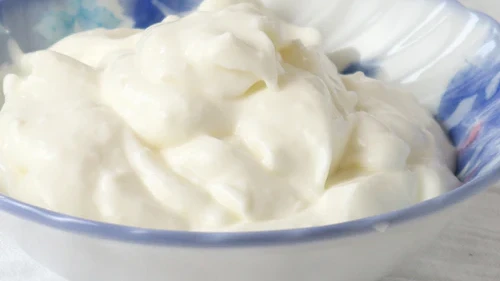Your Cart is Empty
24HR DISPATCH
FREE SHIPPING
24HR DISPATCH
FREE SHIPPING
24HR DISPATCH
FREE SHIPPING

How to make Icelandic Skyr in a yogurt maker
Barb Hodgens
Barb Hodgens loves to cook with alternative, healthy whole food ingredients, with a focus on gut health. Barb has overcome her own gut health issues through healthy eating. Share your ideas, comments and photos at the end of this post :)

It’s super easy and fun to make at home!
Skyr is a delicious, thick, rich and tangy cultured dairy product from Iceland. The texture and taste resemble thick yogurt but, in Iceland it’s regarded as a type of fresh curd cheese that is in the same culinary family as Italian ricotta, German quark, or Middle Eastern labneh.
The process of making skyr, (pronounced skeer) is very much like our homemade Greek yogurt, except the method calls for rennet, a cheese making ingredient be added at the same time as the starter culture. Like all of the above mentioned soft fresh cheeses, skyr is also filtered through a cloth to remove the liquid whey. The consistency of the final product is dependent on how long the cheese is left to strain. We left ours drain for only 2 hours, for a thicker finish leave your skyr hanging for up to 6 hours.

Skyr is most commonly made with skim or low-fat milk and is revered for being full of protein but very low in fat. Historically however, traditional skyr would have been made with whole milk (and most probably raw) as reduced fat milk is a recent industrialised dairy product.
With the addition of rennet, the incubation process is not as exacting or temperature sensitive as homemade yogurt. People find nifty ways to keep their skyr curds warm for hours on end, but the Pure Plus yogurt maker guarantees the process, without the worry, especially in cool weather.
Just like yogurt, you can enjoy skyr both sweet and savoury. One famous way to enjoy skyr is to serve it as a simple dessert with fresh cream, brown sugar and fresh berries, if they’re in season. It’s important not to stir this dessert but rather, experience the unique sensation of the sweet & cream against the tartness.






How to make Icelandic Skyr in a yogurt maker
Luvele
Rated 3.9 stars by 10 users
Skyr is a delicious, thick, rich and tangy cultured dairy product from Iceland. The texture and taste resemble thick yogurt but, in Iceland it’s regarded as a type of fresh curd cheese that is in the same culinary family as Italian ricotta, German quark, or Middle Eastern labneh.
Ingredients
- 2 litres of milk (low fat milk or whole milk) *
- Yoghurt starter culture
-
½ tablet of rennet (either animal or vegetable)
* Depending on how long the curds are left to drain, 2 litres of milk will yield less than 1 litre of skyr. - Cheese or muslin cloth
- A wooden spoon or similar
- Large bowl for capturing the whey
- A thick rubber band
- Glass jar with airtight lid for storing the whey (optional)
YOU ALSO NEED
Directions
- Pour the milk into a large saucepan.
Heat the milk over low heat until the milk reaches 82° C / 180° F. Use a thermometer. Stir the milk occasionally to prevent it from sticking to the bottom of the pan.
Remove the saucepan from the heat and set aside at room temperature. Let it cool to below 43° C /110 ° F. It is fine if the milk cools down well below 42° .
- In a small dish combine the rennet with a tablespoon of water then set aside to dissolve for a few minutes.
Add the yogurt starter culture and the rennet liquid to the milk then whisk to combine.
Pour the milk into the yogurt making glass jar and put the lid firmly on.
- Place the glass yogurt jar into the yogurt maker. Pour water slowly into the base. The water must not be filled over the ‘tall line’ indicated on the inside wall of the maker. Place the cover lid on top. The milk is now ready to begin fermentation.
Use the digital control panel to set the temperature to 36° C (96° F), and the time to 12-hours and then press ‘confirm’ to begin incubation. Curds will form in a few hours. You can leave it for as little as 5 hours or up to 24 hours. A long fermentation will produce a very tart tasting product. A shorter time will be more mild tasting. Experiment and find your preferred taste.
When the fermentation is complete, condensation will have collected under the cover lid. Please take care removing it and allow the water to drip into the water bath, instead of your bench.
Switch the yogurt maker off and remove the jar. Straight from the maker the skyr will be warm but set into a firm curd with whey on top. You can place it in the fridge until you are ready or drain it right away.
- The next step is to drain off the whey. We follow the same method we use to make dripped yogurt cream cheese. You can watch how that’s done here.
We love to cut the curd. Use a knife to cross hatch down into the curds. This is not necessary but it sure is fun!
Scoop the curds into a colander lined with muslin or cheesecloth over a large bowl to catch the whey.
Let the curds sit in the colander for a few minutes to drain then draw up the four corners of the cloth and gently scrunch together. Do not squeeze as this blocks the cloth and slows down the natural separation and drip process.
- Use the rubber band to tightly tie the cloth together. Push a wooden spoon through the rubber band to form a rafter and hang the bundle above the bowl of whey. There is no right way to do this. Make sure the skyr bundle isn’t hanging down too far into the bowl – you want it to clear the whey that will collect at the bottom.
Leave the curds drain in a cool place for a minimum of 2 hours. For a firmer cheese, let it hang for 6 hours.
When it has stopped dripping you can scrape the skyr from the cloth and spoon back into a clean Luvele yogurt jar then store in the fridge.
The fresh skyr is ready to eat as is or it can be transformed into some other culinary fancy. The possibilities are endless.
In the refrigerator homemade sky will keep for about a month and whey for up to 6 months.
Recipe Video
PIN THIS RECIPE


How to make Icelandic Skyr in a yogurt maker

It’s super easy and fun to make at home!
Skyr is a delicious, thick, rich and tangy cultured dairy product from Iceland. The texture and taste resemble thick yogurt but, in Iceland it’s regarded as a type of fresh curd cheese that is in the same culinary family as Italian ricotta, German quark, or Middle Eastern labneh.
The process of making skyr, (pronounced skeer) is very much like our homemade Greek yogurt, except the method calls for rennet, a cheese making ingredient be added at the same time as the starter culture. Like all of the above mentioned soft fresh cheeses, skyr is also filtered through a cloth to remove the liquid whey. The consistency of the final product is dependent on how long the cheese is left to strain. We left ours drain for only 2 hours, for a thicker finish leave your skyr hanging for up to 6 hours.

Skyr is most commonly made with skim or low-fat milk and is revered for being full of protein but very low in fat. Historically however, traditional skyr would have been made with whole milk (and most probably raw) as reduced fat milk is a recent industrialised dairy product.
With the addition of rennet, the incubation process is not as exacting or temperature sensitive as homemade yogurt. People find nifty ways to keep their skyr curds warm for hours on end, but the Pure Plus yogurt maker guarantees the process, without the worry, especially in cool weather.
Just like yogurt, you can enjoy skyr both sweet and savoury. One famous way to enjoy skyr is to serve it as a simple dessert with fresh cream, brown sugar and fresh berries, if they’re in season. It’s important not to stir this dessert but rather, experience the unique sensation of the sweet & cream against the tartness.





PIN THIS RECIPE


Subscribe
Sign up to get the latest on sales, new releases and more …
